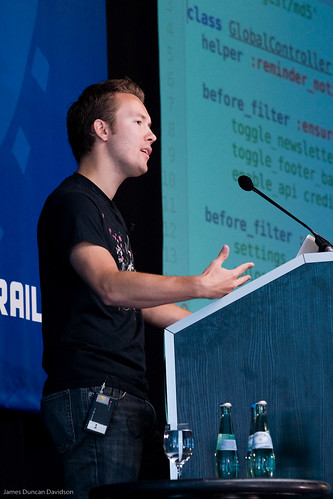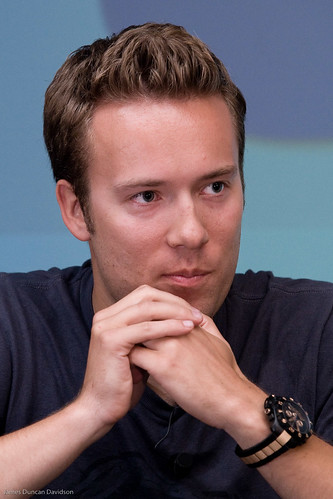I’m in Berlin attending RailsConf Europe 2008. Today was the first day of the conference proper, following an optional day of tutorials yesterday. Following a welcome by Ruby guru David A. Black, the conference started with an hour-long keynote from Ruby on Rails creator David Heinemeier Hansson (DHH).

David Heinemeier Hansson photo credit: James Duncan Davidson
David used his keynote to explore the traditional ideas and attitudes towards legacy code. Continuing his long-running theme of optimizing programmer happiness, David went into some detail looking at why programmers feel unhappy about legacy applications and sometimes even trapped by them. The point is that the code itself doesn’t change; rather the programmer who wrote it does, because they have evolved and learned new things.
He put forward a compelling argument that actually any code that you write will inevitably become legacy code and that when looking back at old code we should not despair, but instead rejoice at how far our knowledge has progressed.
The most interesting part of the presentation was when DHH went into more detail with respect to the 37signals applications. He pointed out that by definition 37signals have the oldest Ruby on Rails application in the world i.e. Basecamp (the Rails framework was extracted from the Basecamp application).
Events took a practical turn when David fired up TextMate and showed us real examples of code in both Basecamp and Highrise that he calls garbage cans. He explained the factors and mistaken ideas that had led to the code going down that path and how he’d refactor it knowing what he does now. He was careful not to show us too much of the source code though! Kudos to him for showing us some of his crap code and proving that he is actually as infallible as the rest of us.
DHH is a confident and compelling public speaker and I really enjoyed his talk. I was fortunate enough to get to spend some time chatting to him this afternoon in the foyer, both as part of a small group and for a brief period individually. I asked David if he gets nervous before such talks, as he always appears very confident. He said that he does get a little nervous but finds that any nerves disappear once he gets going. He also said that he doesn’t rehearse his talks a great deal beforehand, preferring just to run through what he intends to say in his mind.

David Heinemeier Hansson photo credit: James Duncan Davidson
I found that for someone who’s often accused of being arrogant or worse, DHH is actually a really nice guy, who in spite of being jetlagged was genuinely friendly and interested in what others were doing. A personal highlight.
Following the keynote I went to an interesting talk by Matthew Deiters on minimizing network traffic through various caching and optimization techniques, followed by a session on the jQuery JavaScript framework by Yehuda Katz. I didn’t know much about jQuery before today, but like many Rails developers, I’m impressed by how powerful jQuery is given its small distribution size, particularly when compared with Prototype. Although I really enjoy using Prototype, I shall probably migrate to jQuery for future Rails projects. It definitely seems to be edging ahead of Prototype in terms of becoming the modern JavaScript framework of choice.
Juggernaut is an ingenious combination of an invisible Flash file and push server that you can add to a Rails application—it’s actually framework-agnostic—to give it pseudo-realtime capabilities. Alex MacCaw and Stuart Eccles illustrated this with a rather compelling Google Maps mashup, whereby session attendees dropped pushpins representing where they’d come from onto the map and everyone else could see them appear instantly. They also demonstrated a minimal chat application that uses the technology. This is one that I shall definitely be investigating further.
Jonathan Weiss gave a good run down on the top security issues facing Rails applications and how to fix them, although unfortunately he ran out of time at the end.
Following a fairly short talk from Nick Sieger about Sun Microsystems and JRuby, the closing keynote of today was by Jeremy Kemper, who spoke about his recent experiences of optimizing the performance of the 37signals applications. Although not an inspirational speaker like his colleague DHH, Jeremy has a likeable, almost casual speaking style and gave some good detailed tips on how to find and remove the performance bottlenecks within a Rails application. That wraps it up for today, just time to catch some sleep before tomorrow’s packed schedule!
Comments
There aren’t any comments on this post. Comments are closed.